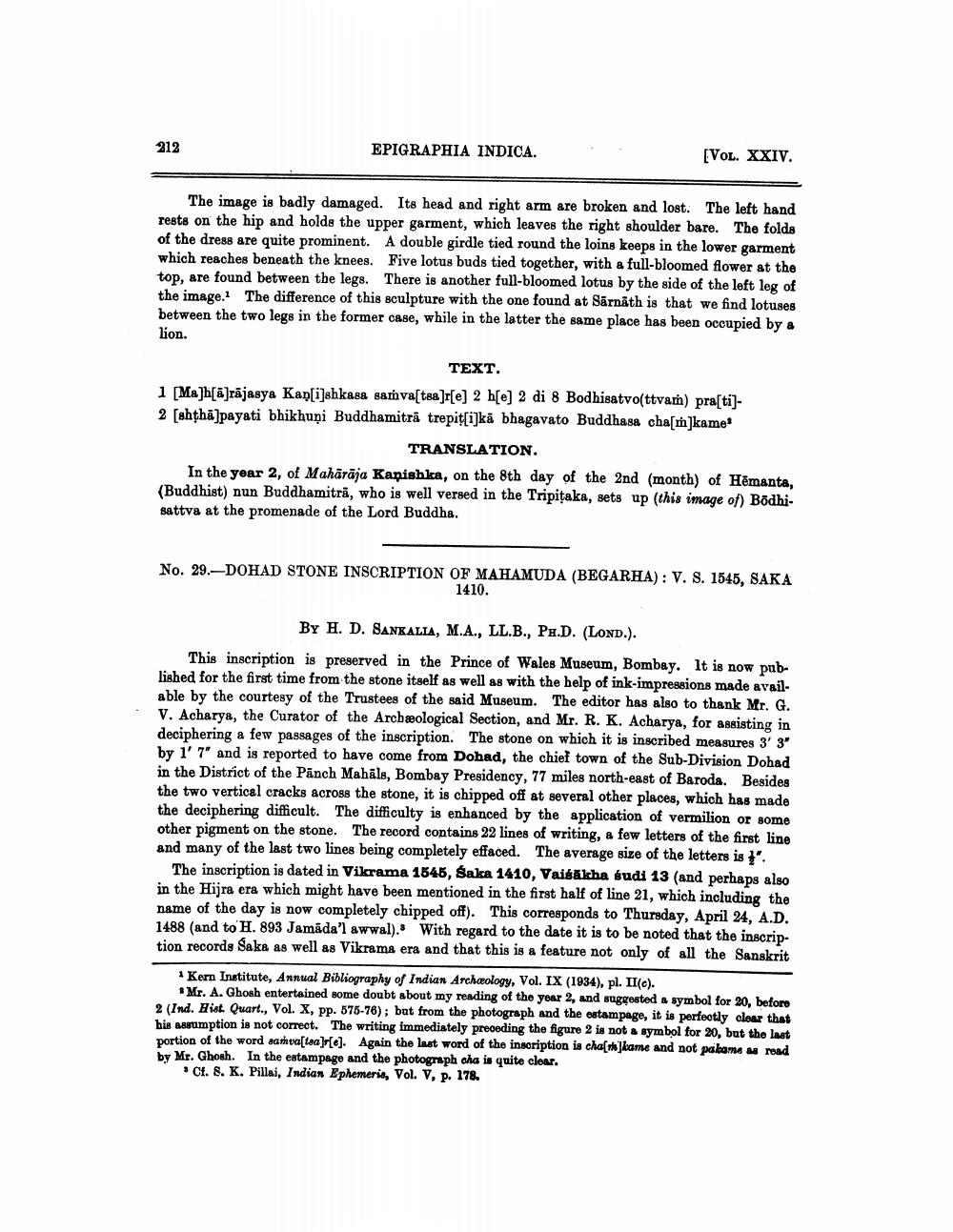________________
212
EPIGRAPHIA INDICA.
[VOL. XXIV.
The image is badly damaged. Its head and right arm are broken and lost. The left hand rests on the hip and holds the upper garment, which leaves the right shoulder bare. The folds of the dress are quite prominent. A double girdle tied round the loins keeps in the lower garment which reaches beneath the knees. Five lotus buds tied together, with a full-bloomed flower at the top, are found between the legs. There is another full-bloomed lotus by the side of the left leg of the image. The difference of this sculpture with the one found at Sarnath is that we find lotuses between the two legs in the former case, while in the latter the same place has been occupied by a lion.
TEXT.
1 [Maharajasya Kan[i]shkasa samva[tsa]r[e] 2 h[e] 2 di 8 Bodhisatvo(ttvam) pra[ti]
2 [shṭhā]payati bhikhuņi Buddhamitra trepit[i]ka bhagavato Buddhasa cha[m]kame
TRANSLATION.
In the year 2, of Mahārāja Kanishka, on the 8th day of the 2nd (month) of Hemanta, (Buddhist) nun Buddhamitra, who is well versed in the Tripitaka, sets up (this image of) Bōdhisattva at the promenade of the Lord Buddha.
No. 29.-DOHAD STONE INSCRIPTION OF MAHAMUDA (BEGARHA): V. S. 1545, SAKA 1410.
BY H. D. SANKALIA, M.A., LL.B., PH.D. (LOND.).
This inscription is preserved in the Prince of Wales Museum, Bombay. It is now published for the first time from the stone itself as well as with the help of ink-impressions made available by the courtesy of the Trustees of the said Museum. The editor has also to thank Mr. G. V. Acharya, the Curator of the Archæological Section, and Mr. R. K. Acharya, for assisting in deciphering a few passages of the inscription. The stone on which it is inscribed measures 3′ 3′′ by 1' 7" and is reported to have come from Dohad, the chief town of the Sub-Division Dohad in the District of the Panch Mahāls, Bombay Presidency, 77 miles north-east of Baroda. Besides the two vertical cracks across the stone, it is chipped off at several other places, which has made the deciphering difficult. The difficulty is enhanced by the application of vermilion or some other pigment on the stone. The record contains 22 lines of writing, a few letters of the first line and many of the last two lines being completely effaced. The average size of the letters is ".
The inscription is dated in Vikrama 1545, Saka 1410, Vaisakha sudi 13 (and perhaps also in the Hijra era which might have been mentioned in the first half of line 21, which including the name of the day is now completely chipped off). This corresponds to Thursday, April 24, A.D. 1488 (and to H. 893 Jamada'l awwal). With regard to the date it is to be noted that the inscription records Saka as well as Vikrama era and that this is a feature not only of all the Sanskrit
1 Kern Institute, Annual Bibliography of Indian Archaeology, Vol. IX (1934), pl. II(c).
Mr. A. Ghosh entertained some doubt about my reading of the year 2, and suggested a symbol for 20, before 2 (Ind. Hist. Quart., Vol. X, pp. 575-76); but from the photograph and the estampage, it is perfectly clear that his assumption is not correct. The writing immediately preceding the figure 2 is not a symbol for 20, but the last portion of the word samvatsar[e]. Again the last word of the inscription is cha[th]kame and not pakame as read by Mr. Ghosh. In the estampage and the photograph cha is quite clear.
Cf. S. K. Pillai, Indian Ephemeris, Vol. V, p. 178.




